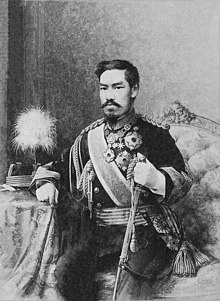

Emperor of Japan
Mutsuhito 3 November 1852 Kyoto Gyoen National Garden, Kyoto, Yamashiro Province, Japan
30 July 1912(1912-07-30) (59) Meiji Palace, Tokyo City, Tokyo Prefecture, Japan
Era datesKeiō: 1867 – 1868 Meiji: 1868 – 30 July 1912
Emperor of Japan from 1867 until 1912 Emperor of Japan Emperor Meiji 明治天皇 Portrait by Edoardo Chiossone (1888)Emperor of JapanReign3 February 1867 – 30 July 1912 Enthronement12 September 1868PredecessorKōmeiSuccessorTaishōShōgunTokugawa Yoshinobu (1866–68)Daijō-daijinSanjō Sanetomi (1871–85)Prime Ministers See list Itō Hirobumi Kuroda Kiyotaka Sanjō Sanetomi Yamagata Aritomo Matsukata Masayoshi Itō Hirobumi Kuroda Kiyotaka Matsukata Masayoshi Itō Hirobumi Ōkuma Shigenobu Yamagata Aritomo Itō Hirobumi Saionji Kinmochi Katsura Tarō Saionji Kinmochi BornMutsuhito (睦仁 ) (1852-11-03 ) 3 November 1852 Kyoto Gyoen National Garden, Kyoto, Yamashiro Province, JapanDied30 July 1912(1912-07-30) (aged 59) Meiji Palace, Tokyo City, Tokyo Prefecture, JapanBurial13 September 1912 Fushimi Momoyama no Misasagi (伏見桃山陵 ) , Kyoto, Kyoto Prefecture, JapanSpouseMasako Ichijō (m. 1869 )Issue Yoshihito, Emperor Taishō Masako, Princess Takeda Fusako, Princess Kitashirakawa Nobuko, Princess Asaka Toshiko, Princess Higashikuni (among others) HouseImperial House of JapanFatherEmperor KōmeiMotherNakayama YoshikoReligionShintoSignature Emperor Meiji (明治天皇 , Meiji-tennō, 3 November 1852 – 30 July 1912) , also called Meiji the Great (明治大帝 , Meiji-taitei) , or Meiji the Good (明治聖帝 , Meiji-seitei) , was the 122nd emperor of Japan according to the traditional order of succession. Reigning from 3 February 1867 until his death on 30 July 1912, and the first monarch of the Empire of Japan, he presided over the Meiji era, and instigated the Meiji Restoration, a series of rapid changes that witnessed Japan's transformation from an isolationist, feudal state to an industrialized world power. At the time of Emperor Meiji's birth in 1852, Japan was a feudal, pre-industrial country dominated by the isolationist Tokugawa shogunate and the daimyō subject to it, who ruled over the country's 270 decentralized domains. By the time of his death in 1912, Japan had undergone an extensive political, economic and social revolution, and emerged as one of the great powers on the world stage. The New York Times summarized this transformation at the emperor's funeral in 1912 with the words: "the contrast between that which preceded the funeral car and that which followed it was striking indeed. Before it went old Japan; after it came new Japan." Since the modern era, when an emperor of Japan dies he is given a posthumous name. Such a name is a combination of the era during which he reigned and coincides with the emperor's contribution to the throne whilst he was alive. Therefore, while publicly known during his life merely as "The Emperor", he has been historically known as "Emperor Meiji" after his death. He obtained this current title in reference to the Meiji era, which spanned almost the entirety of his reign. His personal name (which is not used in any formal or official context, except for his signature) was Mutsuhito (睦仁 ) .

We use cookies
We use cookies and other tracking technologies to improve your browsing experience on our website, to show you personalized content and targeted ads, to analyze our website traffic, and to understand where our visitors are coming from. Privacy Policy.